What is Human Resource Development (HRD)? Guide for HR in 2025
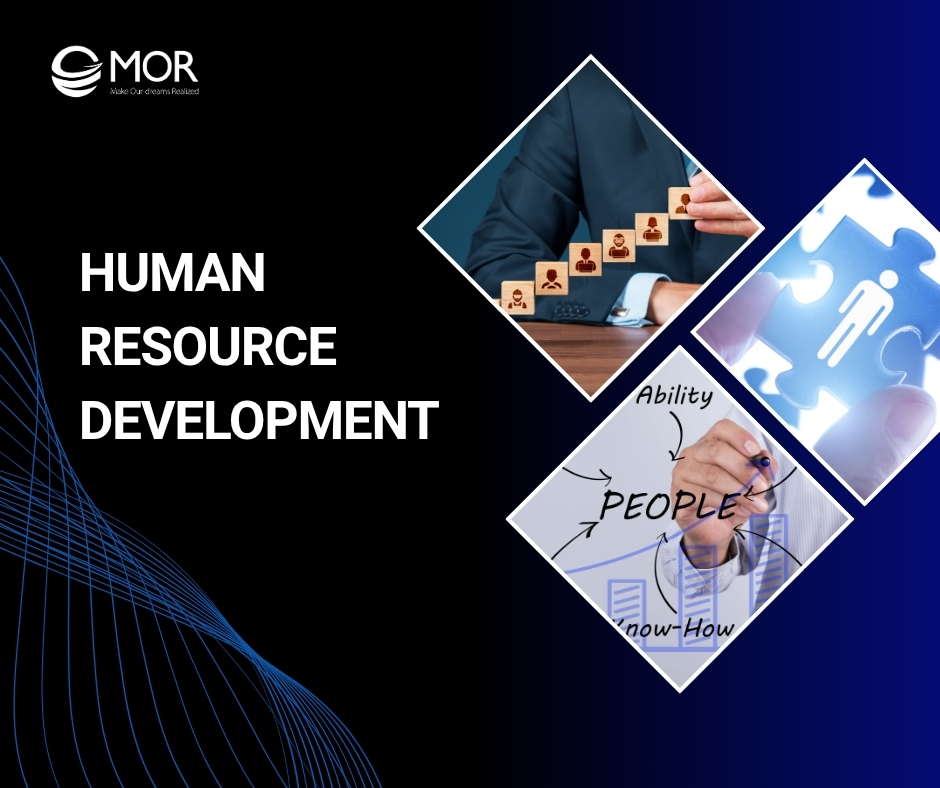
Many businesses still treat human resource development (HRD) as a one-time training event and it shows in low retention, poor engagement, and stalled careers. The truth is, human resources training and development needs to be continuous, flexible, and aligned with real business goals. This MOR Software’s guide will walk you through what HRD really means in 2025, why it matters more than ever, and how to build a system that actually works.
What Is Human Resource Development?
Human resource development is the process of helping employees grow the skills and mindset needed to thrive at work. It often starts with onboarding and continues through job-specific training, leadership coaching, or performance support.
Organizations that invest strategically in employee development report 11% greater profitability and are twice as likely to retain their employees.
A solid HRD plan helps teams get comfortable in their roles, understand company expectations, and stay equipped as the business evolves.
Done right, HRD isn’t just about teaching people how to do tasks. It’s about setting them up for long-term success, whether they’re new hires or long-timers adjusting to new tools or strategies. Many organizations use HRM models to close skill gaps, support internal mobility, or shift culture.
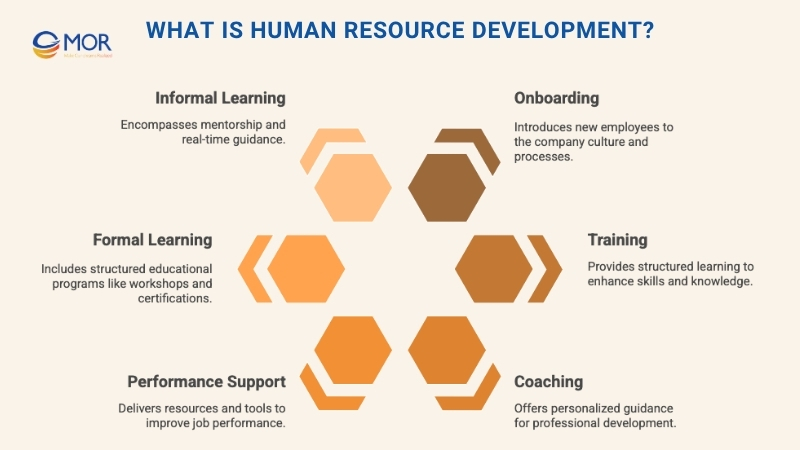
HRD usually takes one of two forms:
- Formal: This could mean bringing in a trainer, building out a course, or creating structured learning paths. Think classroom sessions, certifications, or hands-on workshops.
- Informal: Less rigid, but still powerful. Managers might coach junior staff or guide new hires through real-time problem-solving. There's often no set structure, but the learning is ongoing.
In short, what is a human resource development program? It’s a smart investment that helps people do their best work, and grow while doing it.
Key Elements Of Human Resource Development In The Workplace
Strong human resource development doesn’t happen by accident. It’s built on seven key elements that shape how people join, grow, and stay within an organization. These pillars help connect business needs with the day-to-day experience of every employee.
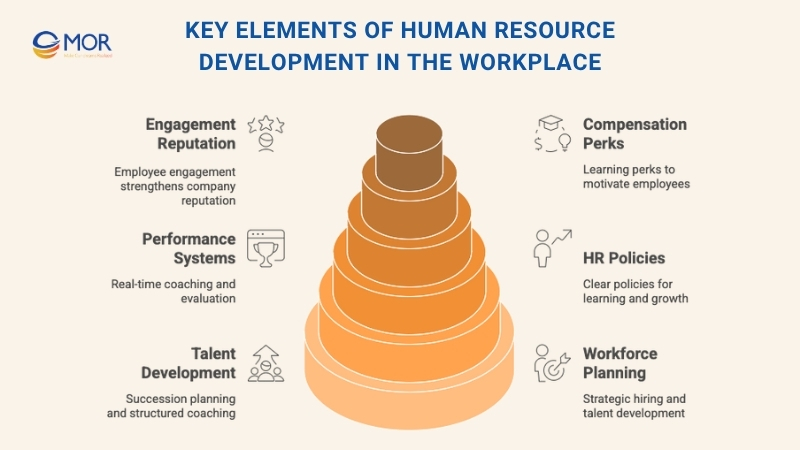
Workforce Planning, Hiring, And Retention Strategies
Getting the right people in the door is only the beginning. Strategic hiring sets the tone for building a capable team, but workforce planning, recruitment, and retention take it a step further. That means thinking ahead, not just reacting to open roles.
Many businesses fall into the trap of chasing ‘perfect-fit’ candidates. But in reality, the best hires might need some training to succeed. That’s where a solid human resources development approach comes in. You’re not just filling gaps, you’re investing in people’s potential.
When teams use data to forecast staffing needs and build internal development paths, they tend to keep talent longer. In fact, companies with a strong learning culture have nearly twice the retention rate, about 57% versus 27% for moderate learning cultures.
That’s especially valuable in tight job markets where relying on experience alone won’t cut it. Planning with growth in mind helps attract, train, and keep the right talent, on your terms.
This first element also touches on human resource development training, showing how strategic hiring blends with upskilling for better retention.
Preparing For Future Roles Through Talent Development
One of the smartest ways to keep your team productive long-term is by developing people for what’s next, not just what’s now. That’s where succession planning and talent development come in.
Rather than scramble when someone leaves, smart contract companies map out key positions and prepare employees to grow into them. This kind of planning doesn’t just cover leadership roles. It applies to any job that’s critical to operations. You might already be doing it informally, but structured HR development makes it easier to scale.
Think of it as building a bench. You identify gaps, offer targeted coaching, and create pathways for internal growth. A clear resource human development plan makes transitions smoother and helps reduce disruption when change happens.
Structured onboarding alone can boost new-hire retention by about 82 %. This shows the value of combining succession planning with practical training.
It’s also great for morale. When employees see a future for themselves inside the company, they’re more likely to stick around. Bonus: it builds stronger connections between teams too.
Developing Internal Policies And Procedures For Growth
Every strong human resource development plan needs a clear foundation, and that starts with the right policies. These aren’t just documents. They’re living tools that guide how teams learn, grow, and succeed together.
You’ll need to spot what your people need, draft the right procedures, and launch them with purpose. But it doesn’t stop there. HR teams also need to track how those policies work in real life. Collect feedback, review adoption, and update regularly to stay relevant.
This kind of training and development in human resource management means being proactive. It also means having goals and benchmarks in place before you roll things out. That’s how you know if your policies are actually helping people thrive.
Aligning Performance Systems With Business Goals
Good development doesn’t happen in a vacuum. It needs structure, and that’s where a solid performance management system fits in. When done right, it links individual efforts to business-wide priorities.
Modern systems use tech and processes to help managers coach, evaluate, and guide team members in real time. They also create space for learning through regular check-ins and reviews.
For HR leaders, it’s key to understand what your tools can do and how to use them to support HRD. Because when performance and development are connected, everyone’s rowing in the same direction.
Using Compensation And Perks To Support Learning
Paychecks matter, but they’re just one piece of the puzzle. A well-rounded compensation and benefits strategy also includes things like flexible time, recognition, and access to growth tools. These extras make a big difference when it comes to keeping people motivated.
Many HR teams now use learning perks as part of their benefits package. Over 90% of employees say they won’t quit if they receive development opportunities, and 45% say they’re more likely to stay in their role when they get more training.
That could mean funding online courses, offering internal workshops, or providing licenses to training platforms. These options all support human resource training and development while boosting employee satisfaction.
People want more than a paycheck. They’re looking for purpose, progress, and a chance to learn. A clear human resource development plan that includes these perks helps attract top talent, and gives current employees a reason to stay.
Strengthening Employee Engagement And Company Reputation
Your team is your best brand ambassador. A strong employer brand isn’t built on ads or slogans, it’s built on how your people feel at work. When you invest in their growth, they talk about it.
Focusing on engagement through human resources development program efforts sends a message. It tells candidates you care. It tells employees they matter. And that message spreads fast.
Create a culture where feedback is real, learning is encouraged, and trust runs deep. That’s how you turn your people into advocates, and build a reputation that attracts more of the right ones.
>>> READ MORE: HR Risk Management: 9 Types Of Risks & Ways To Reduce
Key Benefits Of Investing In Human Resource Development
When done right, human resource development lifts more than individual skillsets, it lifts the entire organization. For HR teams and business leaders, that means better results, happier employees, and stronger teams.
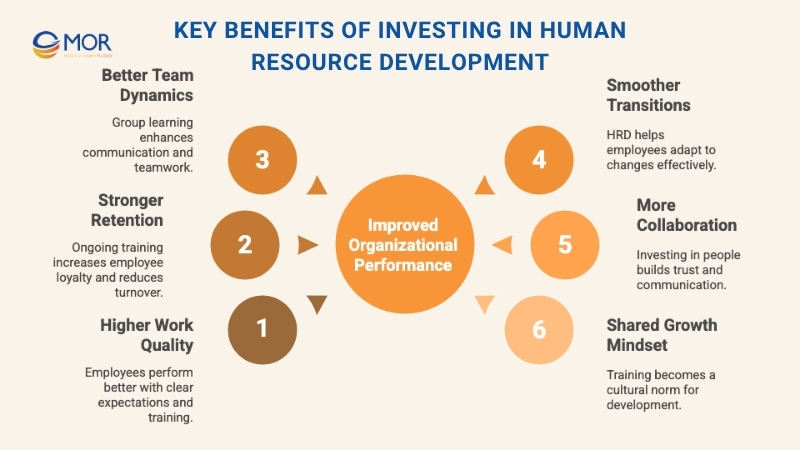
Here’s what effective HRD brings to the table:
- Higher work quality: Clear development paths help employees do their jobs better. When people understand what’s expected and have the right tools, their output improves, fast. That’s the everyday result of strong human resource development training.
- Stronger retention: Training sends a clear message: you’re invested in your people. That kind of support builds loyalty. When employees feel valued, they’re more likely to stay, and you avoid the cost of constant hiring and onboarding.
- Better team dynamics: HRD often includes group learning, mentoring, or job shadowing. Those shared experiences help new hires connect and encourage better communication with managers. That makes for smoother teamwork.
- Smoother transitions during change: Whether it’s new tools, new roles, or new processes, change is easier when people are prepared. HRD helps teams understand the ‘why’ behind change, reducing friction and building buy-in.
- More collaboration: Investing in people creates trust. That trust leads to better group work, more open conversations, and respect across departments. Over time, that’s what makes culture stick.
At its core, training development in human resource management makes growth a shared goal, not just an HR checkbox.
How Human Resource Development Differs From HR Management?
People often confuse human resource development with human resources management, but the two serve different purposes inside an organization.
Human resources management (HRM) focuses on the structure of work. It covers payslip, hiring, compliance, and making sure internal systems run efficiently. It’s about managing day-to-day operations to support business needs. You’ll often see HRM tied closely to compensation, workforce planning, and policy enforcement.
Human resource development (HRD), on the other hand, is all about long-term growth. It starts with onboarding and extends to mentoring, coaching, and ongoing training. The goal is to help individuals grow in their roles while building a more creative, resilient workforce overall.
The two functions often overlap, especially in areas like performance reviews or internal promotions. Both require strong people skills and a solid grasp of workplace culture and behavior. In fact, many human resources development professionals get started through HRM roles or shared degree programs.
One supports operations. The other builds potential. Both matter, and together, they create the foundation for a strong, future-ready company.
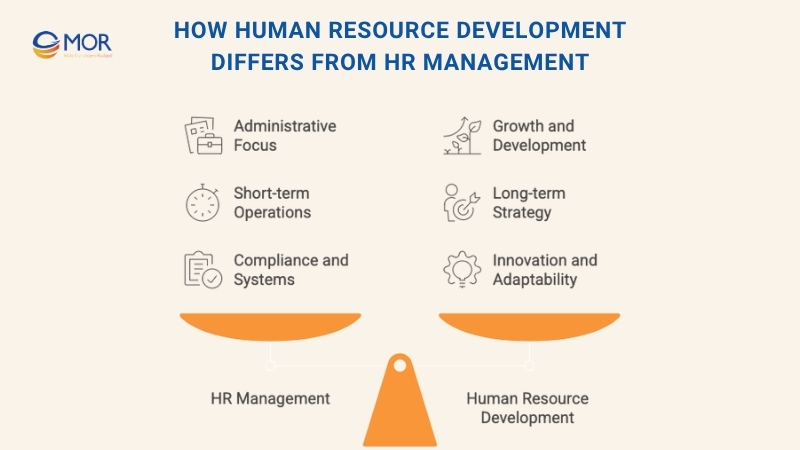
Comparison between HRM vs HRD
Aspect | Human Resource Management (HRM) | Human Resource Development (HRD) |
| Primary Focus | Day-to-day operations and structure of work | Long-term employee learning and growth |
| Key Functions | Payroll, compliance, hiring, workforce planning | Training, mentoring, coaching, upskilling |
| Goal | Maintain internal efficiency and legal standards | Build a skilled, adaptable, and motivated workforce |
| Typical Activities | Managing benefits, enforcing policies, conducting performance reviews | Delivering workshops, onboarding, succession planning |
| Scope of Work | Administrative and organizational | Strategic and developmental |
| Approach to Change | Reactive, focused on solving immediate issues | Proactive, focused on preparing people for future roles |
| Link to Business Strategy | Supports daily business functions | Fuels innovation, adaptability, and long-term success |
| Tools Used | HR software for payroll, scheduling, benefits | LMS platforms, coaching systems, development pathways |
Tips To Apply Human Resource Development Effectively
Strong human resource development doesn’t need to be complicated, but it does need to be intentional. Whether you’re running formal sessions or supporting on-the-job learning, small changes in how you deliver HRD can create bigger, better results.
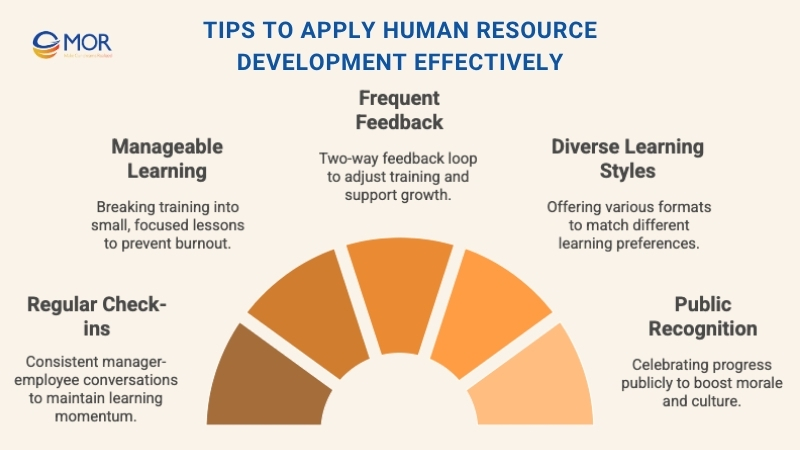
Make Check-Ins A Habit
Regular check-ins keep learning on track. Set up weekly conversations between managers and employees, or schedule recurring coaching sessions with internal facilitators. These don’t need to be long, what matters is consistency.
Whether it’s for mentorship, training recaps, or goal reviews, steady follow-up builds momentum. For structured programs, build in weekly milestones so participants stay focused. This makes internal human resources development easier to manage and more effective over time.
Keep Learning Manageable
Don’t overload people with too much at once. Break learning into smaller steps. Focus on one idea, one tool, or one skill at a time.
When employees can absorb and apply what they learn right away, they’re more engaged, and you’ll see the results faster. This approach to human resources training and development also helps prevent burnout and keeps people motivated to keep going.
Ask For And Give Frequent Feedback
Feedback isn’t a one-time event, it’s a loop. For human resource development to really stick, employees need steady input from their managers or mentors. Not just during evaluations, but as they grow.
At the same time, HR should be collecting feedback too. Use quick surveys or casual check-ins to learn what’s working and what’s not. This feedback helps refine your human resources development programs, making them more relevant and more useful.
When people feel heard, they stay engaged. And when you act on their feedback, they know it matters.
Remember People Learn In Different Ways
There’s no one-size-fits-all in training. Some team members learn best by reading. Others prefer to watch, listen, or try it hands-on. A flexible human resource development approach gives them all a chance to succeed.
The best development programs offer variety. Visual aids, how-to videos, peer shadowing, simulations, each of these meets different learning styles. You can even encourage employees to shape their own development journey.
This is how human resource development training becomes personalized and effective.
Recognize Growth Publicly And Often
People want to be seen. Celebrate progress with real, visible recognition. That might be a shoutout in a meeting, a badge, or a message from leadership.
It doesn’t have to cost much. But when learning and growth are noticed, they become part of the culture. This reinforces your HR development goals and encourages others to stay on track with their own growth.
Recognition fuels motivation, and motivated teams keep learning.
>>> READ MORE: 10 Best HRMS Software Solutions All Startups Should Try in 2025
Human Resource Development Trends to Watch in 2025
The future of human resource development is being shaped by changing roles, rising expectations, and smarter tools. As we move through 2025, these five trends are defining how HR teams support growth at scale.
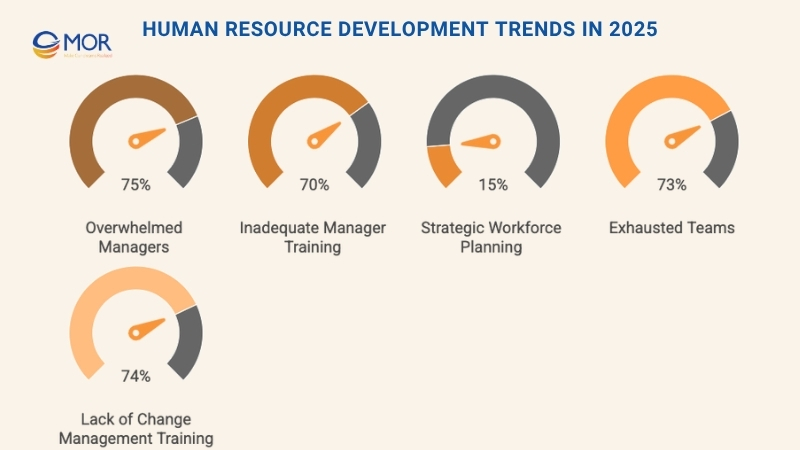
Training Stronger Leaders And Managers
Leadership is getting harder, and most managers feel it. A recent Gartner survey shows 75% of HR leaders say their managers are overwhelmed, and 70% admit their training programs aren’t preparing them for future challenges.
Human resources development now needs to prioritize leadership coaching, real-world skill-building, and smarter support systems. Strong managers build strong teams, so development at the top pays off across the board.
Turning Culture Into Action, Not Just Slogans
Culture still matters, but maintaining it is harder than ever. Over half of HR leaders say managers don’t reinforce values, and many execs don’t model them either.
Human resource development training must now go beyond policies. It needs to help leaders embody company values and guide teams with clarity. That means integrating culture into learning programs, feedback systems, and everyday habits.
Moving Beyond Basic Headcount Planning
Most businesses still plan based on how many people they need, not which skills or roles they’ll need tomorrow. Only 15% of companies are doing true strategic workforce planning.
This is where human resources development has room to lead. Use training data, performance metrics, and internal mobility programs to shape smarter staffing strategies tied to long-term goals.
Supporting Teams Through Rapid Change
From new tech to new structures, employees are dealing with constant change. Yet 73% of HR leaders say their teams are tired, and 74% say managers aren’t trained to lead through disruption.
Resource human development programs that include resilience training, clear communication, and change coaching can help teams adapt without burning out.
Making HR Tech Actually Useful
More tech doesn’t always mean better outcomes. Over half of HR teams say their tools don’t meet evolving needs, and many can’t even measure impact.
For training development in human resource management to scale, HR needs systems that are easy to use, connected, and data-driven. Smart tech makes learning easier to track, personalize, and improve over time.
Build Stronger Human Resource Development Systems With MOR Software
MOR Software helps companies build the right tools to support long-term talent growth. We don’t just develop systems. We shape how HR teams run learning, track progress, and stay aligned with business goals.
Here’s what we bring to the table:
- Custom learning management systems (LMS): Give employees a single place to learn, track progress, and build new skills with ease.
- Performance and feedback tools: Support 360° reviews, goal setting service, and real-time coaching with data-driven dashboards.
- Individual development planning apps: Let your team map out career paths, set growth targets, and monitor progress over time.
- Workplace engagement and culture tracking: Spot gaps in team morale or culture fit early, using integrated survey tools.
- HR digital transformation consulting: We help HR teams adopt cloud, AI automation, and data solutions to modernize how development is managed.
Whether you’re scaling new HRM software development or rebuilding from scratch, MOR Software builds solutions that fit your team’s structure, learning needs, and growth plans.
Conclusion
Human resource development isn’t just a support function, it’s a growth engine. When done right, it helps companies stay competitive, keeps employees engaged, and turns talent into long-term value. Whether you’re updating internal training or rethinking performance systems, MOR Software can help you build the right tools to support lasting growth. Need help building or scaling your HRD system? Contact us to get started.
MOR SOFTWARE
Frequently Asked Questions (FAQs)
What is the main goal of Human Resource Development?
The main goal is to help employees grow professionally so they can perform better, take on new roles, and contribute more to the business over time.
How is Human Resource Development different from training?
Training is often short-term and task-specific. Human Resource Development includes training but also focuses on long-term growth, leadership, and organizational learning.
Who is responsible for Human Resource Development in a company?
HR teams typically lead the process, but managers, executives, and employees all play a role in supporting and participating in development efforts.
Why should small businesses invest in Human Resource Development?
Even small teams benefit from upskilling. Development builds stronger performance, improves retention, and reduces hiring costs in the long run.
What are common tools used in Human Resource Development?
Common tools include LMS platforms, coaching sessions, development plans, performance reviews, internal workshops, and feedback surveys.
Rate this article
0
over 5.0 based on 0 reviews
Your rating on this news:
Name
*Email
*Write your comment
*Send your comment
1